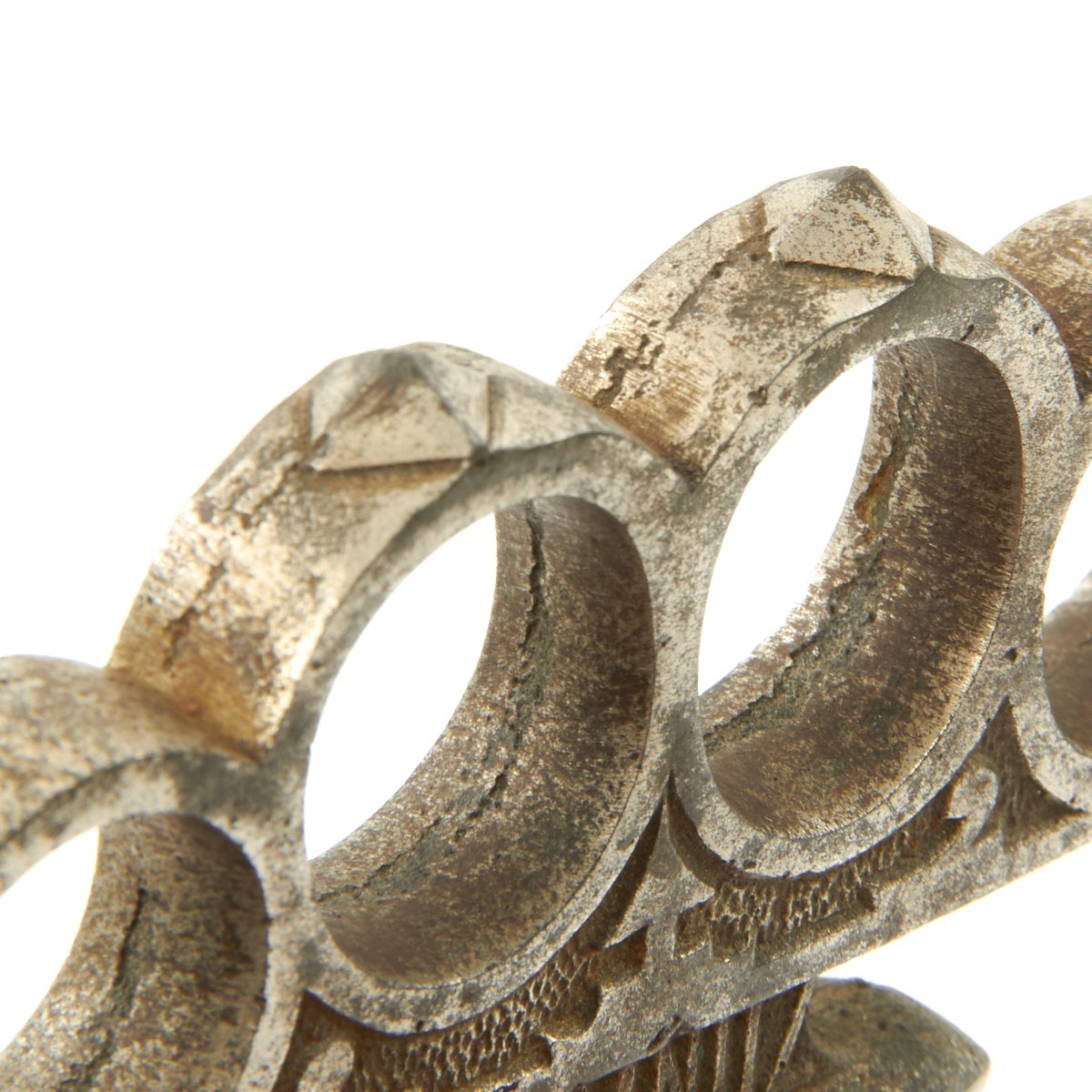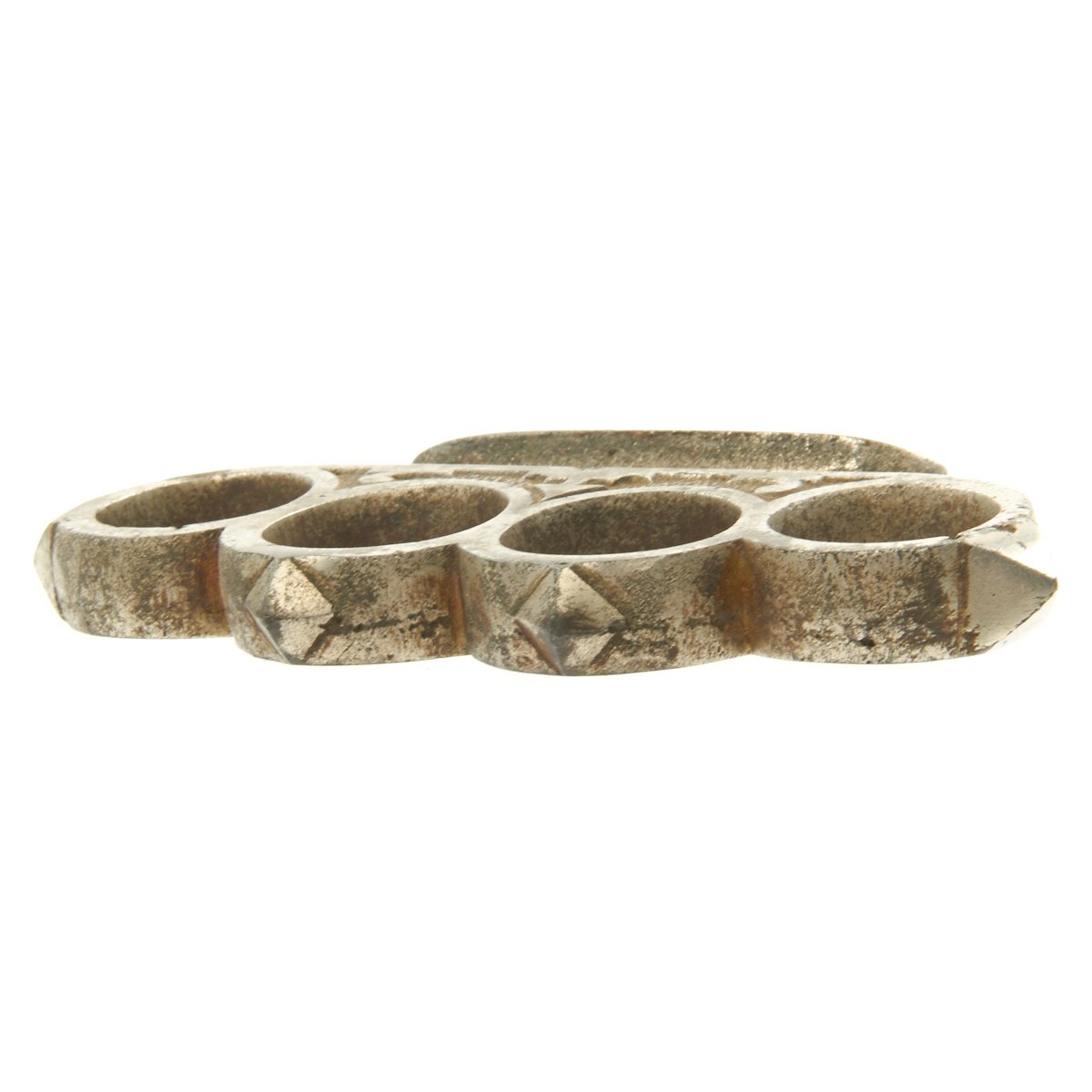Origina German WWII Chemnitz Polizei Brass Knuckles Original Items
$ 495,00 $ 148,50
Original Item: Only One Available. This is an exceptionally rare set of “brass knuckles” constructed from iron and nickel plated. The are cast and the casting reads in bold lettering Chemnitz Polizei. A nearly identical style set without the letter is in the permanent collection at the United States Shoah Memorial Museum as seen at this link.
The knuckles show typical wear and use. Chemnitz suffered massive allied bombing that destroyed 41 per cent of the built-up area of city during the Second World War. Chemnitz contained factories that produced military hardware and a Flossenbürg forced labor subcamp (500 female inmates) for Astra-Werke AG. Chemnitz also housed Stalag IV-F which opened in February 1941, the camp held mainly French troops captured during the battle of France, and British captured in North Africa. The POWs were assigned to various Arbeitskommando (“Work detachments”) locally. The camp was liberated by American forces in March 1945.
Near Chemnitz was the Sachsenburg prison camp which was a NSDAP prison camp in eastern Germany, located in Frankenberg, Saxony. Along with Lichtenburg, it was among the first to be built by the NSDAPs, and operated by the SS from 1933 to 1937. The camp was an abandoned four-story textile mill which was renovated in May 1933 to serve as a “protective custody” facility for dissidents such as Jehovah’s Witnesses, who opposed the NSDAP regime.
The Chemnitz oil refinery was a target for bombers during the Oil Campaign of World War II, and Operation Thunderclap attacks included the following raids:
– 14/15 February 1945: The first major raid on Chemnitz used 717 RAF bombers, but due to cloud cover most bombs fell over open countryside.
– 2/3–5 March: USAAF bombers attacked the marshalling yards.
– 5 March: 760 RAF bombers attacked.
The headquarters of the auto manufacturer Auto Union were also based in Chemnitz since 1932 and its buildings were also badly damaged. At the end of the war, the company’s executives fled and relocated the company in Ingolstadt, Bavaria, where it evolved into Audi, now a brand within the Volkswagen group.
The World War II bombings left most of the city in ruins and post-war, the East German reconstruction included large low rise (and later high-rise Plattenbau) housing. Some tourist sites were reconstructed during the East German era and after German reunification. The city was occupied by Soviet troops on 8 May 1945.
Fast Shipping with Professional Packaging
Thanks to our longstanding association with UPS FedEx DHL, and other major international carriers, we are able to provide a range of shipping options. Our warehouse staff is expertly trained and will wrap your products according to our exact and precise specifications. Prior to shipping, your goods will be thoroughly examined and securely secured. We ship to thousands clients each day across multiple countries. This shows how we're dedicated to be the largest retailer on the internet. Warehouses and distribution centres can be located throughout Europe as well as the USA.
Note: Orders with more than one item will be assigned a processing date depending on the item.
Before shipping before shipping, we'll conduct a thorough inspection of the items you have ordered. Today, the majority of orders will be delivered within 48 hours. The delivery time will be between 3-7 days.
Returns
The stock is dynamic and we cannot completely manage it because multiple stakeholders are involved, including our factory and warehouse. So the actual stock may alter at any time. It's possible that you may not receive your order once the order has been made.
Our policy is valid for a period of 30 days. If you don't receive the product within 30 days, we are not able to issue a refund or an exchange.
You can only return an item if it is unused and in the same state as the day you received it. You must have the item in its original packaging.
Related products
Uncategorized
Uncategorized
Uncategorized
Uncategorized
Australian WWII Owen MK1 Machine Carbine SMG Custom Fabricated Replica with Sling Original Items
Uncategorized
Uncategorized
Uncategorized
Uncategorized
Uncategorized
Band of Brothers ORIGINAL GERMAN WWII Le. F.H. 18 10.5cm ARTILLERY PIECE Original Items
Uncategorized
Uncategorized
Uncategorized
Uncategorized
Uncategorized
Angolan Rebel 1970s era 60mm Inert Display Mortar from Angolan Civil War Original Items
Uncategorized
Uncategorized
Uncategorized













































































